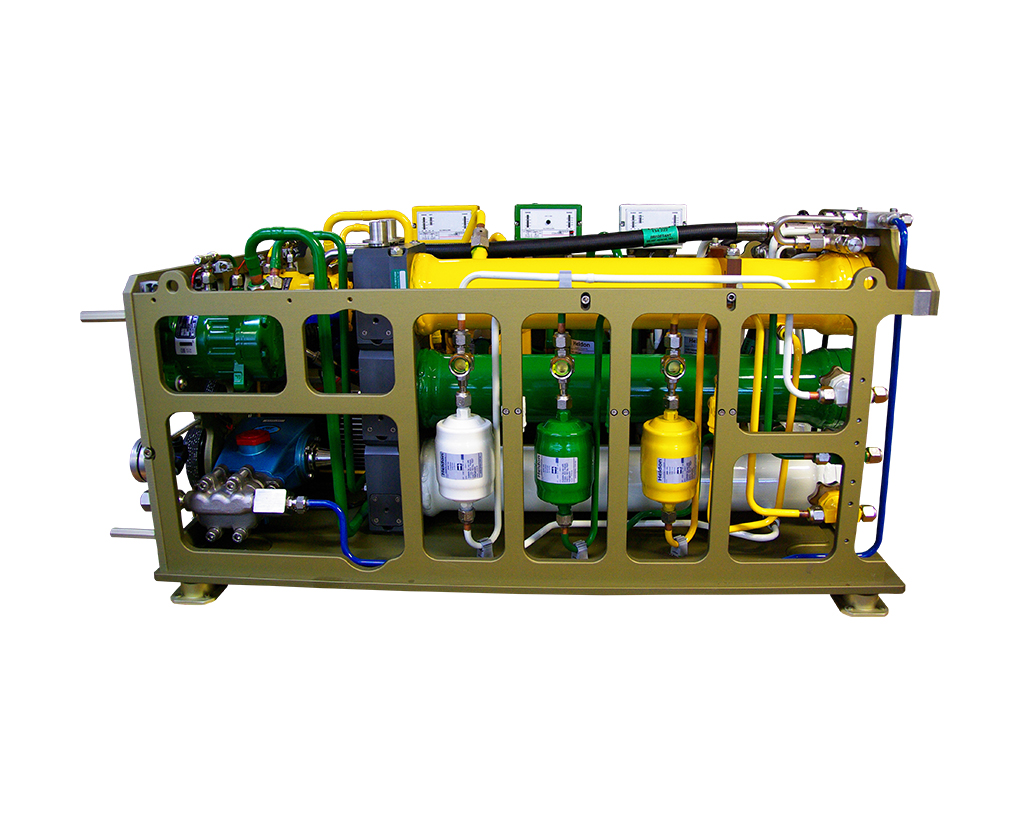Marine Combi System
- – Conventional systems require the continuous running of a generator, thus using fuel andaccumulating an enormous amount of maintenance, as they are virtually forced to run 24/ 7.
- – Available Space: all of the individual units (3 independent condensers, desalinationsystem, deck wash, cruising alternator) all will take a lot of precious space (real estate) on the vessel.
- – To operate all the above mentioned systems, usually requires the installation of anoversized generator and in some instances even two generators (one larger and one smaller).
- – In the conventional systems all the cooling pumps and circulating pumps, including thepriming pump, require a separate AC installation, unlike in the case of Combi, the services are all provided from the Combi’s 24V main system. The main separate brushless motor in the Combi is powered by a special booster that derives the energy from single phase 240V AC/50Hz to 400V DC. All anxillary power for pumps and the air conditioning air handlers are powered by 24V.

Combi equipment on test rig prior to shipment, vacuumed and filled with argon gas, ready for shipment and installation.

Space savings gained in confined engine room and simultaneously counterbalancing the weight of the genset. Appropriate room for servicing unit required.

Typical installation of Combi in a tight spot.

Combi installation in progress in an open engine room with excellent access to all mechanical and electronic connections.

Typical installation of JEC circulating, (cooling & refrigeration) and priming (desalination), pumps supplying a Combi unit as well as cabling, all of which are controlled by the Combi unit.
JEC Combi Components
Compare the number of components in a JEC Combi to the number of components in a comparable conventional system.
| Conventional System | JEC Combi |
|---|---|
| 3 mounted platforms, each containing 1 motor and 1 compressor | 1 mounted platform containing 1 motor and 2 compressors (plus an additional engine-mounted compressor) |
| 3 condensers | 3 condensers |
| 4 large AC pumps | 2 small DC pumps |
| 5-8 circuit breakers (1 for each system, and 1-4 for each AC evaporator) | 2 circuit breakers (1 x AC, 1 x DC and none for a DC evaporator) |
| 3 temperature sensor monitors | 1 temperature sensor monitor |
| 4 isolating switches | 1 isolating switch |
| 4 display/controller units | 1 display/controller unit |
| 4 lots of individual wiring | 1 lot of integrated wiring |
| 4 lots of individual plumbing | 1 lot of integrated plumbing |
We have added:
- Additional power source, using hydraulic power which is plentiful in larger vessels and used only sporadically. This additional power enables the Combi to run more features simultaneously as well it produces a small amount of electric power (4kW 240V AC / 50H), whereby the brushless electric motor that normally powers the Combi becomes Generator.
- Desalination: The unit can produce up to 200l of potable water in one hour and the high pressure pump which is part of the system can be easily switched over into a deck wash, thus saving space and the need to run a generator. “
Secondary Hydraulic Power / Anxillary 4kw 240V 50Hz Power Generation
The Anxillary or cruising power can only be accessed if the Combi system is hydraulically powered. Typically we work with the design team to integrate the hydraulic system to meet all the requirements.
What are the disadvantages of conventional motor driven refrigerator compressors:
General Specifications:
- Two models to choose from:
- AC: 110-240V AC, 50-60Hz using 400V DC brushless motor
- Hydraulic: 10kW precision built hydraulic motor;
- Combi Touch Screen Colour Display drives and allows for monitoring of all compressor clutches, raw water coolant volumes, desalination and deck wash pressures, all internal temperature and pressure settings and air conditioning capacity control. One Combi Display can control up to 20 Combi units with a single 3mm, 75 Ohm input/output co-axial cable;
- Firewall prevents damage to Combi electronic circuits from accidental high voltage inputs. Incorporates mini switchboard providing protection for all Combi-driven pumps and circuits, (approx 10 individual fuses);
- Optional Emergency Manual Override in case of electronic failure, allowing manual switch-over, bypassing all electronic systems;
- Three independent compressors can be dedicated to any combination of air conditioning and/or refrigeration;
Refrigeration Specifications:
- Refrigeration power of up to 47,000 BTU (14kW), using internal compressor;
- Additional refrigeration power of up to 47,000 BTU using external compressor mounted on propulsion engines or genset.
Air Conditioning Specifications:
- Capacity controlled air conditioning power of up to 40,000 BTU (12kW), using internal compressor;
- Temperature and pressure sensors for monitoring air conditioning and refrigeration systems;
- Air volume control of air conditioning handlers;
- A range of compact, speed controlled, 24V DC operated evaporators are available, from 8,000 - 40,000 BTU. Evaporators can be run by gas or chillers. Alternatively, evaporators can be used for heating by circulating the vessel's hot water system or genset/propulsion engine coolant.
Desalination/High Pressure Deck Wash Specifications:
- High pressure pump delivers 13 L/min, (3.5 US gpm), to 105 bar (1,500 psi), ideal for desalination and other high pressure saltwater needs, such as High Pressure Deck Wash (with desired function selectable via switch). Pump output pressure is adjustable via Combi Display;
- Desalination option produces 180-200 L/hr, (53 gph) or 4,800 L/day, (1,270 gpd);
- High Pressure Deck Wash allows you to switch between salt and fresh water.


